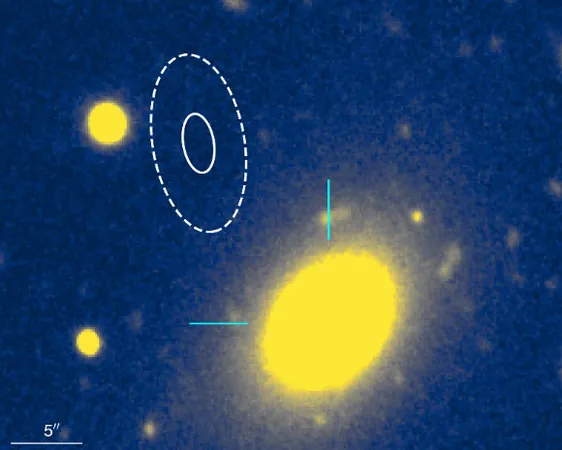
Shocking Discovery: Repeating Fast Radio Burst Found on the Edge of Ancient Galaxy!
2025-01-21
Author: Siti
Astronomers are reeling from a jaw-dropping revelation about a newly detected fast radio burst (FRB) known as FRB 20240209A. This enigmatic signal is traced to the distant outskirts of a seemingly quiet elliptical galaxy, which is a staggering 2 billion light-years away from Earth. With a mass exceeding 100 billion solar masses, this ancient galaxy has been around for about 11.3 billion years, yet it defies expectations about the sources of such powerful cosmic events.
Traditionally, fast radio bursts have been theorized to originate from magnetars — highly magnetized remnants of massive stars that explode as core-collapse supernovae. However, this discovery challenges that narrative. “Typically, we would expect to uncover young stellar remnants in such a powerful burst,” noted astronomer Tarraneh Eftekhari from Northwestern University. “But this galaxy doesn’t show any evidence of recent star formation, pushing the boundaries of what we think we know about FRBs.”
The findings are part of two studies published in the Astrophysical Journal Letters, emphasizing that not all FRBs are linked to regions teeming with new stars. In fact, this intriguing FRB was discovered by the Canadian Hydrogen Intensity Mapping Experiment (CHIME) in February 2024, and has emitted multiple bursts — showing activity 21 times in just a few months.
To better understand this mysterious source, astronomers quickly turned to the W.M. Keck and Gemini observatories for follow-up observations. What they uncovered was unexpected: the FRB emerges from the fringes of an ancient galaxy, far removed from its core, a staggering 130,000 light-years away. According to graduate student Vishwangi Shah from McGill University, “This is both surprising and exciting, as FRBs have typically been found within their host galaxies, often in star-forming areas. To find one so far from the galaxy's center raises profound questions about how such powerful phenomena can emerge in star-depleted zones.”
The researchers hypothesize that the FRB likely originated from a globular cluster, which are dense groups of old stars. These regions might host magnetars formed through various mechanisms, including the merging of two neutron stars or the collapse of a white dwarf. The prospect that FRB 20240209A could reside in a globular cluster adds another layer of intrigue — it could become the second known FRB associated with such a cluster. The team is keen on using the powerful James Webb Space Telescope to investigate this area further.
“There’s still so much we have yet to uncover about FRBs and their origins,” Dr. Eftekhari emphasized. “This discovery suggests that the environments surrounding these bursts could hold critical clues to unraveling the mysteries of the universe.”
In a field where every finding reshapes our cosmic understanding, FRB 20240209A serves as a stark reminder that the universe is full of surprises waiting to be explored. What other secrets might lie hidden in the distant cosmos? Stay tuned as astronomers delve deeper into this cosmic enigma!




 Brasil (PT)
Brasil (PT)
 Canada (EN)
Canada (EN)
 Chile (ES)
Chile (ES)
 Česko (CS)
Česko (CS)
 대한민국 (KO)
대한민국 (KO)
 España (ES)
España (ES)
 France (FR)
France (FR)
 Hong Kong (EN)
Hong Kong (EN)
 Italia (IT)
Italia (IT)
 日本 (JA)
日本 (JA)
 Magyarország (HU)
Magyarország (HU)
 Norge (NO)
Norge (NO)
 Polska (PL)
Polska (PL)
 Schweiz (DE)
Schweiz (DE)
 Singapore (EN)
Singapore (EN)
 Sverige (SV)
Sverige (SV)
 Suomi (FI)
Suomi (FI)
 Türkiye (TR)
Türkiye (TR)
 الإمارات العربية المتحدة (AR)
الإمارات العربية المتحدة (AR)